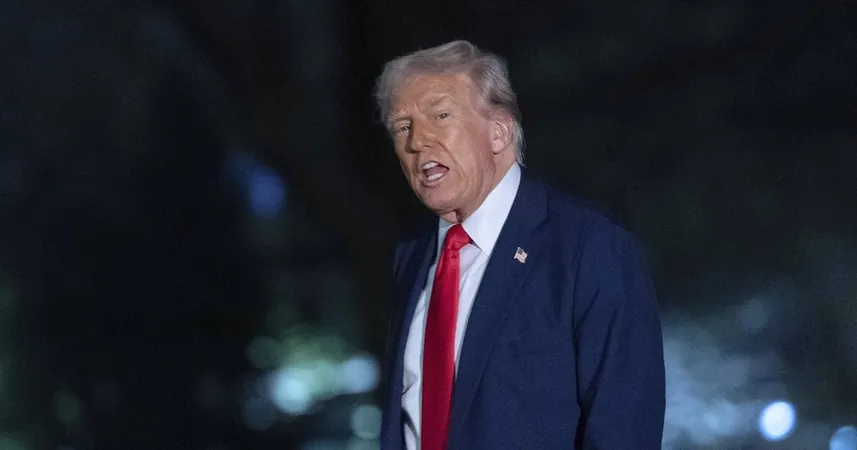
Should Canada Embrace a Dual Fighter Jet Strategy? Balancing U.S. and European Defense Options
2025-03-28
Author: Charlotte
Introduction
In the ongoing debate surrounding Canada’s plan to acquire new fighter jets, the question of whether to commit fully to the Lockheed Martin F-35 Lightning II or to diversify its fleet by incorporating European models has taken center stage. With the Canadian government’s proposed $19 billion purchase of 88 F-35s under scrutiny, it’s essential to weigh the pros and cons of this ambitious military investment.
Advantages of the F-35
Starting with the F-35, it is often hailed as the premier aircraft in its class. Featuring advanced stealth technology and superior situational awareness, the F-35’s capabilities outshine those of its competitors. Designed to engage seamlessly in networked combat, this aircraft can detect and identify threats from great distances, making it a formidable asset for any air force. Canada has already integrated itself into the F-35 supply chain, with 110 Canadian companies participating in the program since its inception in 1997, which ensures local economic benefits as the military relies on a familiar American technology.
Disadvantages of Sole Reliance on the F-35
However, the disadvantages of a sole reliance on American fighter jets cannot be ignored. Recent political dynamics indicate a deteriorating relationship between Canada and the U.S. The potential for tariffs under the Trump administration raises legitimate concerns about Canada’s dependency on American defense systems. Prime Minister Mark Carney has expressed doubts regarding the reliability of the U.S. as a strategic partner, driving the discourse toward the necessity of independent defense strategies.
Moreover, technical vulnerabilities concerning the F-35 are worth noting. Although fears of a “kill switch” that disables Canadian jets on command are overstated, Canadian operators face risks related to a supply chain dependent on U.S. support for parts and upgrades. With rising operational demands, the need for spare parts and maintenance is critical; these logistics issues could hinder Canada’s operational effectiveness.
Consideration of European Aircraft
As Canada navigates its commitment to the F-35, an intriguing alternative emerges: hybridizing its air force by including European aircraft. Canada is legally obliged to purchase the initial 16 F-35s, but it has the flexibility to consider supplementing its order with European models such as the Eurofighter Typhoon, Dassault Rafale, or Saab Gripen. The Typhoon and Rafale, in particular, offer European engines, granting them greater autonomy from U.S. restrictions.
The Gripen stands out as a compelling option, especially with Saab’s commitment to manufacture and assemble the jets in Canada, thereby generating thousands of jobs. Its lower acquisition and operating costs further enhance its attractiveness, enabling Canada to potentially acquire more aircraft without overwhelming its budget.
Geopolitical Implications
From a geopolitical perspective, fostering stronger ties with Europe aligns with Mr. Carney’s strategic shift, prioritizing partnerships beyond North America. Investment in European defense initiatives could yield financial, employment, and technological benefits for Canada, as the EU ramps up military spending with significant financial incentives for member states to bolster their defense capabilities.
Conclusion and Future Outlook
Currently, Canada faces a critical decision regarding its defense spending and strategic partnerships. The outcome of the upcoming federal elections could drastically alter its F-35 commitment, raising concerns about retaliatory measures from the U.S. If the government intends to carve out a unique defense posture, one potential solution would be to acquire 44 F-35s while also investing in a mix of European fighters. This dual approach would not only placate American interests but also bolster Canada’s autonomy and innovation in defense matters.
Indeed, while operating two types of aircraft may strain resources, the long-term independence from U.S. fluctuations and geopolitical tensions could prove invaluable. As Canada surveys its future in military readiness, a balanced approach could secure both its national security and its economic interests for years to come.









 Brasil (PT)
Brasil (PT)
 Canada (EN)
Canada (EN)
 Chile (ES)
Chile (ES)
 Česko (CS)
Česko (CS)
 대한민국 (KO)
대한민국 (KO)
 España (ES)
España (ES)
 France (FR)
France (FR)
 Hong Kong (EN)
Hong Kong (EN)
 Italia (IT)
Italia (IT)
 日本 (JA)
日本 (JA)
 Magyarország (HU)
Magyarország (HU)
 Norge (NO)
Norge (NO)
 Polska (PL)
Polska (PL)
 Schweiz (DE)
Schweiz (DE)
 Singapore (EN)
Singapore (EN)
 Sverige (SV)
Sverige (SV)
 Suomi (FI)
Suomi (FI)
 Türkiye (TR)
Türkiye (TR)
 الإمارات العربية المتحدة (AR)
الإمارات العربية المتحدة (AR)